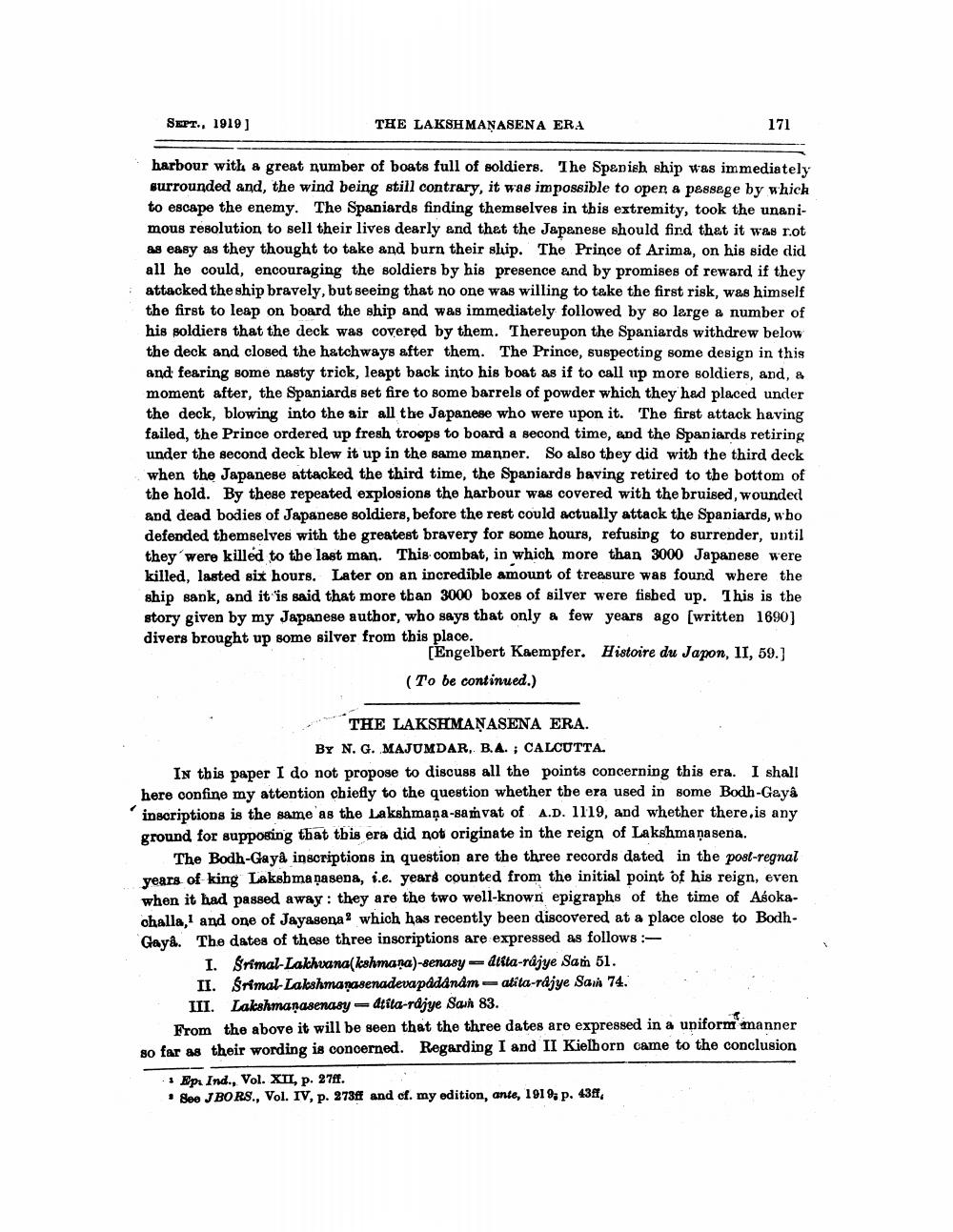________________
SEPT., 1919)
THE LAKSHMAŅASENA ERA
171
harbour with a great number of boats full of soldiers. The Spenish ship was immediately surrounded and, the wind being still contrary, it was impossible to open a passage by which to escape the enemy. The Spaniards finding themselves in this extremity, took the unanimous resolution to sell their lives dearly and thet the Japanese should find that it was r.ot as easy as they thought to take and burn their ship. The Prince of Arima, on his side did all he could, encouraging the soldiers by his presence and by promises of reward if they attacked the ship bravely, but seeing that no one was willing to take the first risk, was himself the first to leap on board the ship and was immediately followed by so large a number of his soldiers that the deck was covered by them. Thereupon the Spaniards withdrew below the deck and closed the hatchways after them. The Prince, suspecting some design in this and fearing some nasty trick, leapt back into his boat as if to call up more soldiers, and, & moment after, the Spaniards set fire to some barrels of powder which they had placed under the deck, blowing into the air all the Japanese who were upon it. The first attack having failed, the Prince ordered up fresh troops to board a second time, and the Spaniards retiring under the second deck blew it up in the same manner. So also they did with the third deck when the Japanese attacked the third time, the Spaniards having retired to the bottom of the hold. By these repeated explosions the harbour was covered with the bruised, wounded and dead bodies of Japanese soldiers, before the rest could actually attack the Spaniards, who defended themselves with the greatest bravery for some hours, refusing to surrender, until they were killed to the last man. This combat, in which more than 3000 Japanese were killed, lasted six hours. Later on an incredible amount of treasure was found where the ship sank, and it is said that more than 3000 boxes of silver were fisbed up. This is the story given by my Japanese author, who says that only a few years ago (written 1690) divers brought up some silver from this place.
[Engelbert Kaempfer. Histoire du Japon, II, 59.] (To be continued.)
THE LAKSHMANASENA ERA.
BY N. G. MAJUMDAR, B.A. ; CALCUTTA. In this paper I do not propose to discuss all the points concerning this era. I shall here confine my attention chiefly to the question whether the era used in some Bodh Gaya inscriptions is the same as the Lakshmaņa-samvat of A.D. 1119, and whether there is any ground for supposing that this era did not originate in the reign of Lakshmaṇasena.
The Bodh-Gayà inscriptions in question are the three records dated in the posl-regnal years of king Lakshmanasena, i.e. years counted from the initial point of his reign, even when it had passed away : they are the two well-known epigraphs of the time of Asokachalla, and one of Jayasena? which has recently been discovered at a place close to BodhGaya. The dates of these three inscriptions are expressed as follows:
I. Srimal-Lakhuana(kshmana)-senasy-dita-rajye Sam 51. II. Srimal- Lakshmanasenadevapadanam - atita-rajye Sain 74. III. Lakshmanasenasy-drita-rdjye San 83.
From the above it will be seen that the three dates are expressed in a uniform manner so far as their wording is concerned. Regarding I and II Kielborn came to the conclusion
1 Ep. Ind., Vol. XII, p. 274. • Seo J BORS., Vol. IV, p. 373ff and of. my edition, ante, 1919, p. 43f




